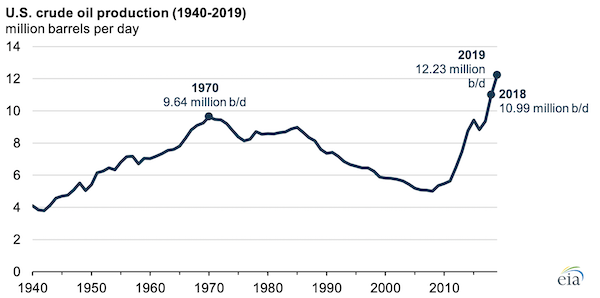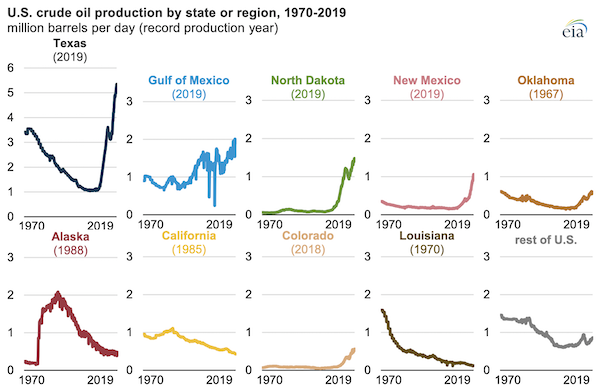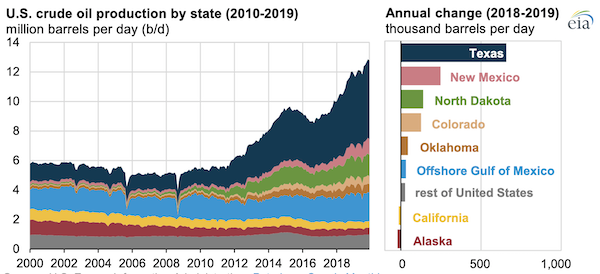Annual U.S. crude oil production reached another record level at 12.23 million barrels per day (b/d) in 2019, 1.24 million b/d, or 11%, more than 2018 levels. The 2019 growth rate was down from a 17% growth rate in 2018. In November 2019, monthly U.S. crude oil production averaged 12.86 million b/d, the most monthly crude oil production in U.S. history, according to the U.S. Energy Information Administration’s (EIA) Petroleum Supply Monthly. U.S. crude oil production has increased significantly during the past 10 years, driven mainly by production from tight rock formations developed using horizontal drilling and hydraulic fracturing to extract hydrocarbons.

Texas continues to produce more crude oil than any other state or region of the United States, accounting for 41% of the national total in 2019. Texas crude oil production averaged 5.07 million b/d in 2019 and reached a monthly record of 5.35 million b/d in December 2019. Texas’s production increase of almost 660,000 b/d in 2019—driven by significant growth within the Permian region in western Texas—was 53% of the total U.S. increase for the year. Texas crude oil production has grown by 3.9 million b/d, or 333%, since 2010.\
Several other U.S. states or regions set production records in 2019. In addition to contributing to Texas’s record production year, the Permian region drove a 248,000 b/d, or 36%, crude oil production increase in New Mexico. This increase was the second-largest state-level growth in 2019 and accounted for 20% of the total U.S. increase. In 2019, New Mexico set a new oil production record for the third consecutive year, growing by 749,000 b/d since 2010.

In the Offshore Federal Gulf of Mexico (the U.S. controlled waters in the Gulf of Mexico), new projects contributed to the region’s growth in production in 2019. Oil and natural gas producers brought online seven new projects in 2019, and EIA expects nine more will come online in 2020. The Offshore Federal Gulf of Mexico’s crude oil production grew by 126,000 b/d in 2019, leading to the area’s highest annual average production of 1.88 million b/d. The Offshore Federal Gulf of Mexico was the second-largest crude oil producing region in the United States in 2019.
Colorado and North Dakota also set record production levels in 2019 of about 514,000 b/d and 1.4 million b/d, respectively. The Niobrara shale formation drove production increases in Colorado, and continued production in the Bakken region drove increases in North Dakota. Production in Oklahoma increased by 32,000 b/d in 2019 but did not surpass Oklahoma’s record production of 613,000 b/d set in 1967.
Increases in these states and regions more than offset production declines elsewhere. Alaska’s crude oil production decreased for the second year in a row, and California’s production declined for the fifth year in a row.

In its latest Short-Term Energy Outlook, EIA forecasts U.S. crude oil production will continue to increase in 2020 to an average of 13.2 million b/d and to 13.6 million b/d in 2021. Most of the expected production growth will occur in the Permian region of Texas and New Mexico.
Principal contributor: Emily Geary

Follow us on social media: